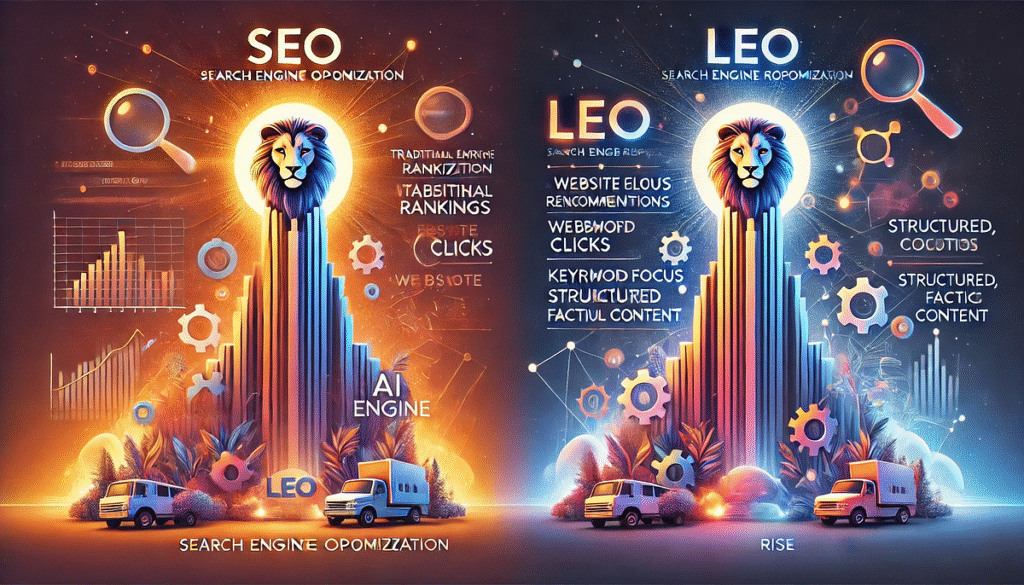Introduction
Search Engine Optimization (SEO) has been the bedrock of digital visibility for two decades. However, the rise of AI-driven interfaces—particularly Large Language Models (LLMs) like ChatGPT, Claude, Gemini, and others—is ushering in a new paradigm: LEO, or LLM Engine Optimization. Unlike SEO, which focuses on ranking web pages on Google, LEO is about getting your brand, product, or information referenced by AI systems during user queries. This guide is a comprehensive deep dive into LEO: what it is, why it matters, its relationship with SEO, the future of backlinking, tools to win the LEO race, and a detailed step-by-step guide to make your website LEO-compliant.
Chapter 1: What Is LEO?
Definition
LEO stands for Large Language Model Engine Optimization. It is the practice of optimizing your content, brand presence, data architecture, and online assets so that LLMs include your content in responses, summaries, or recommendations.
Difference from SEO
- SEO targets search engine algorithms (Google, Bing) to rank web pages.
- LEO targets AI language models trained on vast corpora, often including web, books, datasets, and forums.
How LLMs Fetch Answers
LLMs like ChatGPT do not crawl the web in real-time. Instead, they generate answers based on the data they were trained on and fine-tuned with. In some cases, plugins or web-browsing tools may allow limited real-time access, but the core output is generated based on static data.
To optimize for LEO, you must:
- Ensure your data exists in sources likely to be part of LLM training sets.
- Make your brand or entity contextually strong.
- Be linked, cited, and mentioned in authoritative places.
- Align your content to natural language questions.
Chapter 2: Will LEO Replace Traditional SEO?
Short Answer: No, but it will redefine it.
SEO will continue to matter, especially for web traffic. However, a significant portion of user queries is now handled directly by LLMs—especially in chatbots, customer service, AI assistants, and smart search.
Use-case divergence:
- SEO will remain dominant for transactional search, product discovery, and long-tail queries.
- LEO will dominate informational queries, conversational AI, and personal assistants.
Future scenario: If 30–50% of queries bypass Google and are handled directly by ChatGPT-like systems, LEO becomes mission-critical for visibility.

Chapter 3: Does Backlinking Still Matter?
The Role of Backlinks in LEO
Backlinks still matter, but not in the same way.
- SEO: Backlinks = authority, PageRank boost.
- LEO: Backlinks = citation likelihood, trust signal, source credibility.
How Backlinks Help in LEO
- Sources with strong backlink profiles are more likely to be used in LLM training sets.
- Cited content on authoritative domains (e.g., .edu, .gov, major publishers) is preferred.
- The context of backlinks (anchor text, paragraph) helps establish entity relevance.
In LEO, backlinks become semantic connectors that boost your brand/entity salience across the training datasets.
Chapter 4: Why LEO Matters
- AI Is the New Search Frontline : People are increasingly searching through AI tools instead of traditional search engines.
- Conversational Interfaces Are the Future : Consumers are asking LLMs everything from “best startups in AI cameras” to “which health ring is best for sleep?” Being the answer matters more than ever.
- Static Website Pages Aren’t Enough
- The days of stuffing keywords are over. LLMs look for:
- Semantic relevance
- Natural language flow
- Authoritative tone
- The days of stuffing keywords are over. LLMs look for:
- Thought Leadership as a Ranking Signal : Brands that publish original insights, whitepapers, case studies, and research are more likely to be referenced by LLMs.
- It’s a Winner-Takes-Most Game : Unlike SEO’s top 10 SERP model, LEO is binary: either you’re in the AI answer or you’re not.
Chapter 5: How to Make Your Website LEO Compliant – Step-by-Step Guide

Step 1: Identify Your Entity and Knowledge Graph Placement
- Claim and structure your brand entity.
- Get listed on Wikipedia, Crunchbase, Product Hunt, GitHub, etc.
- Structure About Us and Team pages like knowledge graphs (schema.org)
Step 2: Optimize for Semantic Clarity
- Use clear H1-H6 hierarchy.
- Use synonyms and related terms naturally.
- Use structured Q&A formats that mimic human questions.
Step 3: Publish Original, Expert-Level Content
- Long-form thought leadership blogs.
- Case studies, how-to guides.
- Dataset documentation and open source releases.
Step 4: Build Brand Mentions and Signals
- Guest posts on authoritative sites.
- Podcasts, webinars, YouTube interviews.
- Get quoted in articles (use HARO or Featured).
Step 5: Distribute Content in LLM-Favored Channels
- Reddit, Quora, Medium (public, high-quality sources).
- GitHub (for technical content).
- Google Scholar and ArXiv (for research-heavy domains).
Step 6: Add Structured Data Markup
- Use schema.org for Person, Organization, Article, Product.
- Ensure proper metadata: author, date, keywords, language.
Step 7: Monitor LEO Metrics
- Track how often your brand appears in ChatGPT/Gemini/Bing Chat answers.
- Use tools like Forefront, Poe, or ChatGPT browsing mode for sample queries.
Chapter 6: LEO Tools Available in the Market
1. ChatGPT + Web Mode
Great for testing what content LLMs are referencing. Run test queries like:
- “What is the best AI edge camera?”
- “Best tools for semantic search in video”
2. Poe.com (Anthropic, GPT-4, Claude)
Test how your brand or content shows up across different LLM providers.
3. Surfer SEO / Frase.io
Though built for SEO, these tools help structure semantically rich content for both SEO and LEO.
4. Schema Markup Generators
- Merkle Schema Generator
- RankRanger Structured Data Tool
5. Entity Search API (Google’s Knowledge Graph API)
Use it to see if your entity is in the Google Knowledge Graph—an important feature often included in LLM training data.
6. AI SEO Tools
- EasyGen
- Jasper AI
- MarketMuse
Chapter 7: Winning the LEO Race – Strategies That Work

1. Create Content That Answers Natural Questions
Use tools like AlsoAsked, AnswerThePublic to identify natural language queries.
2. Position Yourself as a Topical Authority
Pick your niche and dominate it with:
- Consistent publishing
- Cross-platform visibility
- Mentions and citations
3. Collaborate With Experts & Entities
Co-author papers, blogs, and videos with thought leaders who are already cited.
4. Build a Web of Context
Distribute similar but customized narratives across Reddit, Quora, Medium, Substack, and niche forums.
5. Reverse Engineer LLM Responses
Analyze answers given by ChatGPT and Claude for your key terms. What sources do they reference? Emulate that content.
Chapter 8: Video Resources and Communities
YouTube Channels
- Nathan Gotch: For advanced SEO-to-LEO strategies
- Julian Goldie: LEO breakdown for bloggers
- Omni AI: Focused on AI discovery, LEO use cases
Sample Video Titles
- “Why SEO is Dead and LEO is the Future”
- “Get Featured in ChatGPT Answers – LEO Explained”
- “How I Optimized My Site for LLM Engines”
Conclusion
LEO is not a buzzword. It is a fundamental shift in digital content strategy. As LLMs become the primary interface between people and knowledge, the ability to be discoverable by these models will dictate who wins the next digital visibility game.
SEO was about beating algorithms. LEO is about teaching machines to understand and prefer your voice.
Get LEO-ready. The AI search era has begun.

